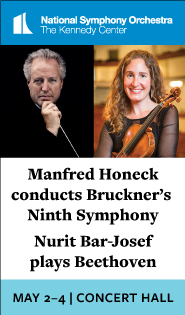Mark Elder brilliantly opens two-week residency with NSO

Mark Elder conducted the National Symphony Orchestra in music of Strauss and Haydn Thursday night. Photo: Jan Bealovega
The National Symphony Orchestra hosted Mark Elder at its podium just last year. No complaints here that the principal conductor of Manchester’s Hallé Orchestra is back this month for a two-week mini-residency. The first installment of his visit, heard Thursday night in the Kennedy Center Concert Hall, paired two composers full of surprises, Joseph Haydn and Richard Strauss.
Such unexpected juxtapositions are a hallmark of Elder’s programming. On the first half of this concert were two pieces not played by the NSO in at least two decades. Elder featured the orchestra’s outstanding woodwinds and horn section in Strauss’s Serenade for 13 Wind Instruments. It is a youthful work, without so much as a whiff of the later, daringly chromatic Strauss, more an aping of the Romantic harmonies of Weber or Brahms.
What it did boast was the wonderfully mellow sound of the NSO’s woodwinds, mostly led by principals except for the flutes. Elder chose to conduct, something not entirely necessary, standing on the floor rather than the raised platform, and he helped coordinate a performance marked by consummate ensemble unity and impeccable intonation. The only disappointment was the interference of a feedback buzz somewhere in the hall, which mercifully was cut off before the return of the soft opening section of music at the end.
Elder is right, as he said in charming commentary before Haydn’s Symphony No. 80, that we should all be listening to more Haydn symphonies. The NSO last played this example in 1987, and Elder led a rarefied, accomplished rendition of this relatively late work. The reduced number of string players, under 40 in total, minimized the application of vibrato, keeping intonation issues to a minimum by a careful, soft approach.
Ever the trickster, Haydn ends the exposition of the first movement with a clownish closing theme, a humble “oom-pa-pa” that bumbles along cluelessly. It becomes the main focus of the development and closes out a movement of contradictions. The extended second movement, graceful and animated, revealed some intonation weakness in the horns in exposed passages. Here the strings had their time in the sun after the woodwind focus in the opening Strauss work, and they shone brightly.
After the short and sweet Menuetto, the finale was a rollicking game of rhythmic displacement, the main gesture of the first violins entirely syncopated, disjointed by a half-beat from the rest of the orchestra. Elder’s gestures and rehearsal preparation helped make this tour de force almost effortless, a triumph of orchestral cooperation under the guise of disagreement.
The only work on the program heard recently from the NSO was Strauss’s Ein Heldenleben. An autobiographical tone poem about a composer’s bitter struggles, the piece had excellent representation for its three major characters. Abel Pereira led a stalwart horn section in the heroic theme representing the composer, answered by the consoling violin solos of concertmaster Nurit Bar-Josef. In the extended cadenza for the instrument, representing the composer’s devoted wife, Pauline, Bar-Josef wove a spell that both soothed and cajoled the dejected composer back into action.
In opposition were the woodwinds as those “nattering nabobs of negativism,” the music critics, led by Doktor Döhring (Theodor Döhring, a disapproving Munich critic), signaled by a quasi-medieval, parallel-motion motif in the low brass. Pointed interjections from the offstage trumpets launched the battle scene between the two sides, and throughout Strauss quoted his own earlier tone poems with reckless delight. The final brass apotheosis of the piece grows out of the well-known trumpet motif that opens Also sprach Zarathustra, one of many moments Elder shepherded into confident being in this concert.
The program will be repeated 8 p.m. Friday. kennedy-center.org; 202-467-4600


